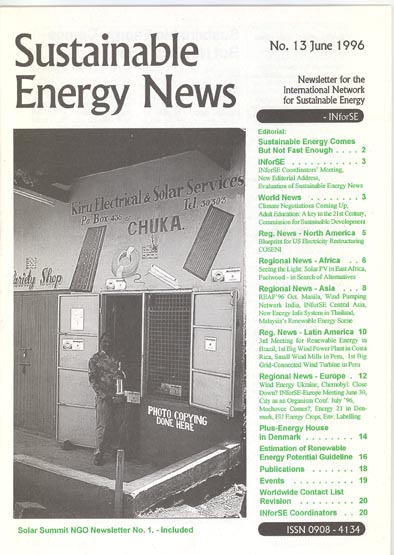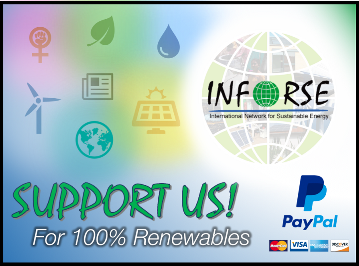|
|
|
|
|
|
|
|
|
|
|
|
|
|
|
|
|
|
|
|
|
| Follow Us: |
| Malaysia's Renewable Energy Scene | |
|
Excerpted from a report published by Center for Environment, Technology & Development, Malaysia (CETDEM) a Malaysian NGO, member of INforSE. Solar energy is abundant in Malaysia. Still it has not been very popular. The report, after a 9-month research funded by DANCED Malaysia, identifies the bottlenecks and suggests means to break the impasse. Malaysia has fossil fuel reserves and plans to extend its grid to the majority of the country. On the other hand, renewable energy is freely available, environmentally benign, and a necessary tool for economic growth and sustainable development. Renewable Energy is an obvious choice to meet the rapidly increasing energy demand. Renewables' Scene The solar radiation level is high, ranging from 6.6kWh/m2 in January to 6.0kWh/m2 in August, which is ideal for several applications. Solar drying is a traditional method to process food like coffee, pepper, paddy; to store fish and fruits; to process tobacco. The farmers dry their products under the sun on cement or on trays. The consumers accept the quality and taste of such products. Driers are used only when they want to reach acceptable export standards, e.g., for cocoa, tea, and food products. Solar water heaters (SWH) have been commercially available since the late '70s. There are companies that are involved in manufacturing, assembling, and marketing the system. In 1990, an estimated 5,460 units were in use, and a 15% annual growth rate was expected. SWHs have achieved market acceptance without extensive promotional activities. SWH is seen as a symbol of modernity. Its visibility to others enhances the owner's self-image. The major problem is that only 3% of households have income capability to buy it. The PV system usage for telecommunication stations is well established, but it has not got popular among the public like the SWHs. This is due to problems with systems installed in the 80s; high, increasing energy demand cannot be met with small systems; and the fact that the utilities are expanding the grid rapidly. However, there are about 60 villages where PV installations are planned for 1996/97. The palm oil industry is rapidly expanding. Presently, there are 2.4 million ha of plantations processed by 271 palm-oil mills. Renewable-energy utilization is a well established part of the industry's success stories. The energy from the residues is used to power improved technology. The natural rubber output of Malaysia, one of the world's leading producers, was 1 million tonnes in 1995. The rising demand from the furniture industry decreases the residue's usage as fuelwood and charcoal for the steel industry, which is 30,000t/yr. The rice straw and husks are used for soil conditioning, but the rice wastes disposed of on-site at the rice mills has potential for energy use in cogeneration systems. Biogas usage at pig farms is limited. The waste is not treated, just washed away in the waterways. The forest residues are not considered economic to transport. Sawmill residues are used for making wood briquettes. An ASEAN-EC COGEN program gave RM3.6 M to fund 6 demonstration cogeneration plants. The hydro power potential is significant. 39 mini-hydro plants are in operation from the 125 planned during the 4th Malaysian Plan. The wind power potential seem to be more viable at off-shore islands, but it has not been assessed yet. The first wind turbine was installed in 1995 with a capacity of 150kW for electricity and desalination of sea water. Need for Action There is a lack of awareness in many areas of renewable energy utilisation among the policy makers and the public as well. The lack of policy to give incentives to develop and utilize renewable energy resulted in a lack of coordination in terms of research and application. Further, the large subsidies on conventional energy reduces the interest for alternatives. CETDEM has proposed a number of actions to overcome the barriers for renewable energy, including: - Publicise renewable energy efforts and success stories via conferences and the mass media, - Get the benefits of renewable energy endorsed by the Prime Ministers Economic Planning Unit, to make the state institutions use more renewable energy, - Identify local organizations with valuable experiences in the field, - Identify and encourage organizations that would like to train staff to work for renewable energy; and organize courses for this group, - Form a "Clearing House" to collect and disseminate information on renewable energy, - Initiate discussions among government, industry and NGOs on legislation and economic incentives to promote renewable energy. - Meet the needs for demonstration plants, information and education . More info: Gurmit Singh K.S. & Foo Hee Boon, CETDEM, PO Box 382, 46740 Petaling Jaya Malaysia, Ph: 603-77-57767, fax: 603-77-54039, email: cetdem@po.jaring.my. TABLE: Renewable Energy, 1994 Use Potential - Palm Oil: 75.7 PJ 155.5 PJ - Rubber wood: 15.0 PJ 40.5 PJ - Forest Resid. 7.5 PJ 22.5 PJ - Solar: 0.23 PJ 9.1 PJ - Minihydro: 0.17 PJ - - Wind: 1260 MJ - - Livestock: 9362 MJ 3x10^8 MJ - Padi: 3062 MJ 5.7PJ - Total: 98.6 PJ - Primary Energy Supply '94 [PJ], (Chart) |
|

| |
| Published in Sustainable Energy News |
|
|
Go back to main page of ISSUE #13 Sustainable Energy News (16 pages) (1996-06-30) 
|
|
| Contact | |
| |
INFORSE Secretariat Klosterport 4F, 1. floor DK-8000 Aarhus C Denmark Phone: +45 86 22 70 00 Twitter: INFORSE_org Facebook: INFORSE Web: inforse.org E-mail: ove@inforse.org |
